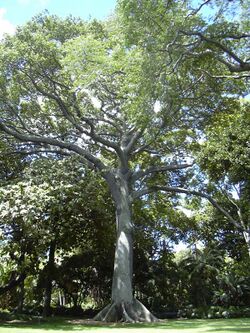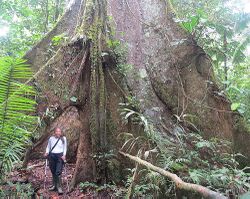Biology:Ceiba pentandra
| Ceiba pentandra | |
|---|---|

| |
| In Honolulu | |
| Scientific classification | |
| Kingdom: | Plantae |
| Clade: | Tracheophytes |
| Clade: | Angiosperms |
| Clade: | Eudicots |
| Clade: | Rosids |
| Order: | Malvales |
| Family: | Malvaceae |
| Genus: | Ceiba |
| Species: | C. pentandra
|
| Binomial name | |
| Ceiba pentandra | |
| Synonyms[2] | |
| |
Ceiba pentandra is a tropical tree of the order Malvales and the family Malvaceae (previously emplaced in the family Bombacaceae), native to Mexico, Central America and the Caribbean, northern South America, and (as the variety C. pentandra var guineensis) West Africa. A somewhat smaller variety has been introduced to South and Southeast Asia, where it is cultivated.
The tree and the cotton-like fluff obtained from its seed pods are commonly known in English as kapok, a Malay-derived name which originally applied to Bombax ceiba, a native of tropical Asia.[3] In Spanish-speaking countries the tree is commonly known as "ceiba" and in French-speaking countries as fromager. The tree is cultivated for its cottonlike seed fibre, particularly in south-east Asia, and is also known as the Java cotton, Java kapok, silk-cotton or samauma.
Characteristics

The tree grows up to 240 ft (73 m) tall as confirmed by climbing and tape drop[4] with reports of Kapoks up to 77 meters (252 feet) tall.[5] These very large trees are in the Neotropics or tropical Africa. The Southeast Asian form of C. pentandra only reaches ninety feet (27 meters).[6] Trunks can often be up to 3 m (10 ft) in diameter above the extensive buttress roots. The very largest individuals, however, can be 5.8 m (19 ft) thick or more above the buttresses.[7][8][9][10]
The buttress roots can be clearly seen in photographs extending 12 to 15 m (40 to 50 ft) up the trunk of some specimens[11] and extending out from the trunk as much as 20 m (65 ft) and then continuing below ground to a total length of 50 m (165 ft)[12][13]
The trunk and many of the larger branches are often crowded with large simple thorns. These major branches, usually 4 to 6 in number, can be up to 1.8 m (6 ft) thick[14][15] and form a crown of foliage as much as 61 m (201 ft) in width.[16] The palmate leaves are composed of 5 to 9 leaflets, each up to 20 cm (8 in) long.
The trees produce several hundred 15 cm (6 in) pods containing seeds surrounded by a fluffy, yellowish fibre that is a mix of lignin and cellulose.
The referenced reports make it clear that C. pentandra is among the largest trees in the world.
Uses
The commercial tree is most heavily cultivated in the rainforests of Asia, notably in Java (hence one of its common names), the Philippines, Malaysia, and Hainan Island in China, as well as in South America.
The flowers are an important source of nectar and pollen for honey bees and bats.
Bats are the primary pollinators of the night-blooming flowers.
Native tribes along the Amazon River harvest the fibre to wrap around their blowgun darts. The fibres create a seal that allows the pressure to force the dart through the tube.
The fiber is light, very buoyant, resilient, resistant to water, but very flammable. The process of harvesting and separating the fiber is labor-intensive and menial. It is difficult to spin, but is used as an alternative to down as filling in mattresses, pillows, upholstery, zafus, and stuffed toys such as teddy bears, and for insulation. It was previously popularly used in life jackets and similar devices - until synthetic materials largely replaced the fiber. The seeds produce an oil that is used locally in soap and which can also be used as fertilizer.
Traditional medicinal uses
Ceiba pentandra bark decoction has been used as a diuretic, as an aphrodisiac, and to treat headache, as well as type II diabetes. It is used as an additive in some versions of the psychedelic drink Ayahuasca.[citation needed]
Seed oil
A vegetable oil can be pressed from the seeds. The oil has a yellow colour and a pleasant, mild odour and taste,[17] resembling cottonseed oil. It becomes rancid quickly when exposed to air. Kapok oil is produced in India, Indonesia and Malaysia. It has an iodine value of 85–100; this makes it a nondrying oil, which means that it does not dry out significantly when exposed to air.[17] The oil has some potential as a biofuel and in paint preparation.
Religion and folklore
The tree is a sacred symbol in Maya mythology.[18]
It is a sacred tree in Palo, Arará and Santería.[19][20]
According to the folklore of Trinidad and Tobago, the Castle of the Devil is a huge C. pentandra growing deep in the forest in which Bazil the demon of death was imprisoned by a carpenter. The carpenter tricked the devil into entering the tree in which he carved seven rooms, one above the other, into the trunk. Folklore claims that Bazil still resides in that tree.[21]
Most masks from Burkina Faso, especially those of Bobo and Mossi people, are carved from C. pentandra timber.[22]
Symbolism
Ceiba pentandra is the national emblem of Guatemala,[18] Puerto Rico,[23] and Equatorial Guinea. It appears on the coat of arms and flag of Equatorial Guinea.[24]
The Cotton Tree was a landmark in downtown Freetown, Sierra Leone, and is considered a symbol of freedom for the former slaves that immigrated there. The 70-metre-tall trunk snapped near the base, and fell in a storm on 24 May 2023.[25]
Saigon, one of a number of older names for Ho Chi Minh City, may be derived from Sài (Sino-Vietnamese "palisade" etc.) and the Vietnamese name for the Kapok tree (bông) gòn, although, in this instance, the tree intended to be named may well be, not the New World Ceiba pentandra, but the Old World Bombax ceiba.
Gallery
-
Canopy
-
Underside of single leaf
-
Thorny buttress roots and trunk base
-
Flowers in profile
-
Fruit close-up
-
Twigs laden with dehiscent fruit showing kapok
-
Single dehiscent fruit revealing kapok-surrounded seeds
-
Dehisced fruit having shed shrivelled valves
See also
- The Great Kapok Tree
- Xtabay
- Parque de la Ceiba
- Fiber crop
References
- ↑ Rivers, M.C.; Mark, J. (2017). "Ceiba pentandra". IUCN Red List of Threatened Species 2017: e.T61782438A61782442. doi:10.2305/IUCN.UK.2017-3.RLTS.T61782438A61782442.en. https://www.iucnredlist.org/species/61782438/61782442. Retrieved 19 November 2021.
- ↑ 2.0 2.1 "Ceiba pentandra". Royal Botanic Gardens, Kew. http://powo.science.kew.org/taxon/urn:lsid:ipni.org:names:1166232-2.
- ↑ "Bombax ceiba (PROSEA)". https://uses.plantnet-project.org/en/Bombax_ceiba_(PROSEA).
- ↑ <anonymous> (May 22, 2010). "Very huge tree in Thailand". http://www.ents-bbs.org/viewtopic.php?p=3084.
- ↑ "mayanodyssey.com - Informationen zum Thema mayanodyssey.". http://www.mayanodyssey.com/costa-rica/osa-peninsula.htm.
- ↑ Prof. E.J.H. Corner, Wayside Trees of Malaya Volume 1 p. 436
- ↑ David G. Campbell, LAND OF GHOSTS (Boston: Houghton-Mifflin, 2005) p. 129.
- ↑ "Tambopota Rainforest Preserve, Peru, 2000". http://www.drwren.com/photo_album/Tambop00/033.htm.
- ↑ "Peru Journals". http://www.drwren.com/peru/journal.html#0804.
- ↑ "amazonCeiba-big-tree-rf223". http://www.ecology.com/wp-content/uploads/2012/12/amazonCeiba-big-tree-rf223.jpg.
- ↑ Dr. Al C. Carder, FOREST GIANTS OF THE WORLD (Markham, Ontario: Fitzhenry and Whiteside, 1995) p. 145 (Photo plate 123 with caption).
- ↑ Peter A. Furley D. Phil. and Walter W. Newey Ph.D., GEOGRAPHY OF THE BIOSPHERE (London: Butterworth, 1983) p. 279.
- ↑ Michael Bright et al, 1000 WONDERS OF NATURE (London: Reader's Digest Assoc., 2001) p. 332.
- ↑ Linda Gamlin and Anuschka de Rohan, MYSTERIES OF THE RAINFOREST (Pleasantville, N.Y.: Reader's Digest Assoc., 1998) p. 79.
- ↑ Ivan T. Sanderson and David Loth, IVAN T. SANDERSON'S BOOK OF GREAT JUNGLES (New York: Simon and Schuster, 1965) p. 78.
- ↑ Dr. Al C. Carder, GIANT TREES OF WESTERN AMERICA AND THE WORLD (Madeira Park, British Columbia: Harbour Publishing, 2005) p. 129. Measured by Prof. Robert van Pelt in 2003.
- ↑ 17.0 17.1 "Kapok seed oil". http://www.tis-gdv.de/tis_e/ware/oele/kapok/kapok.htm.
- ↑ 18.0 18.1 Hellmuth, Nicholas (March 2011). "Ceiba pentandra". Revue Magazine. http://www.maya-archaeology.org/FLAAR_Reports_on_Mayan_archaeology_Iconography_publications_books_articles/23_Ceiba-pentandra-sacred-tree-for-Classic-Maya_Revue_Magazine-Mar-2011.pdf. Retrieved 2013-04-28.
- ↑ Cabrera, Lydia (2006). El Monte. Editorial Letras Cubanas. p. 171ff. ISBN 978-959-10-1546-4.
- ↑ Ramírez Cabrera, Luis E. (2014). Diccionario básico de religiones de origin africano en Cuba. Editorial Oriente. p. 77. ISBN 978-959-11-0972-9.
- ↑ "Tobago's Avatar – 'The tree of life'". Tobago News. 2012-03-01. http://www.thetobagonews.com/opinion/-Tobagos-Avatar--The-tree-of-life-141135673.html.
- ↑ Bontadi, Jarno; Bernabei, Mauro (March 2016). "Inside the Dogon Masks: The Selection of Woods for Ritual Objects". IAWA Journal / International Association of Wood Anatomists 37: 84–97. https://www.researchgate.net/publication/298728256.
- ↑ Philpott, Don (2003). Landmark Puerto Rico. Hunter Publishing, Inc. p. 14. ISBN 9781901522341.
- ↑ Berry, Bruce. "Equatorial Guinea". CRW Flags. http://www.crwflags.com/fotw/flags/gq.html.
- ↑ "Sierra Leone's symbolic Cotton Tree falls during storm in Freetown". The Guardian. Agence France-Presse. 25 May 2023. https://www.theguardian.com/world/2023/may/25/sierra-leone-symbolic-cotton-tree-falls-during-storm-in-freetown.
External links
- Kapok Fibers
- Seed Fibers
- Germplasm Resources Information Network: Ceiba pentandra
- Ceiba pentandra in Brunken, U., Schmidt, M., Dressler, S., Janssen, T., Thombiano, A. & Zizka, G. 2008. West African plants – A Photo Guide. Forschungsinstitut Senckenberg, Frankfurt/Main.
Wikidata ☰ Q138617 entry
 |









